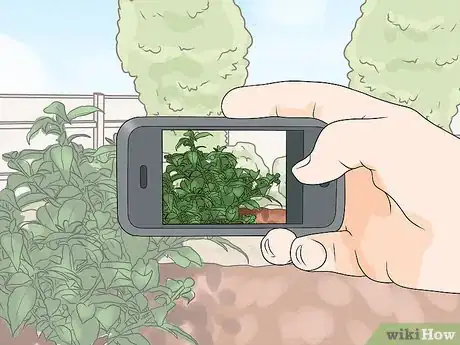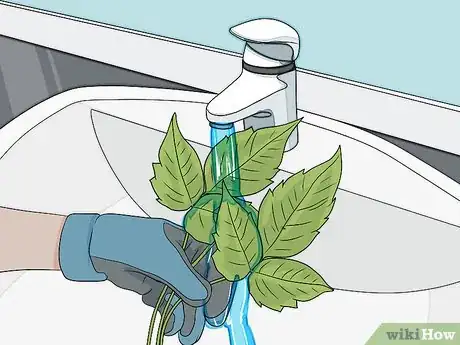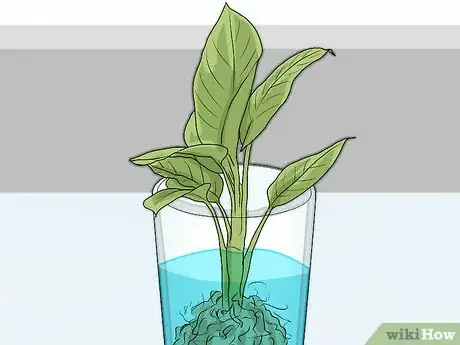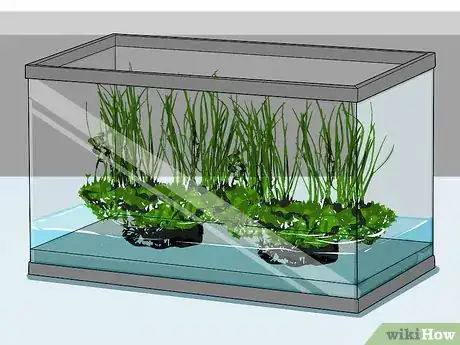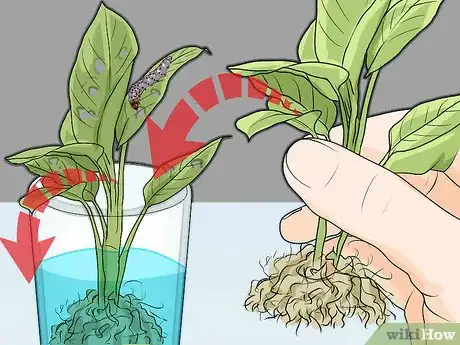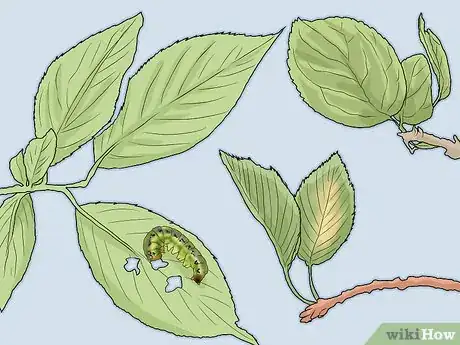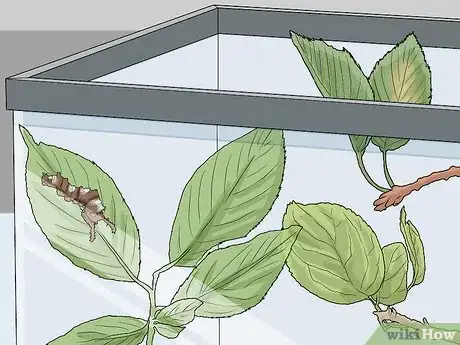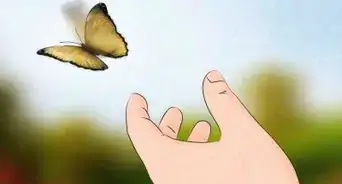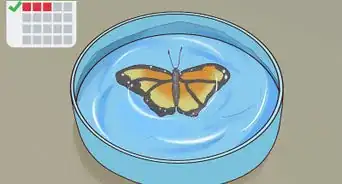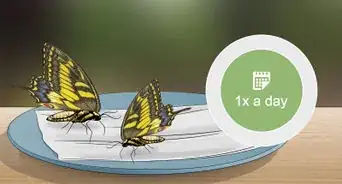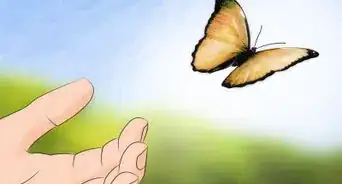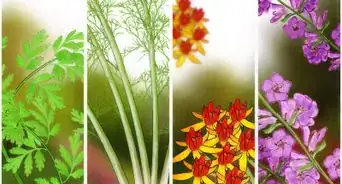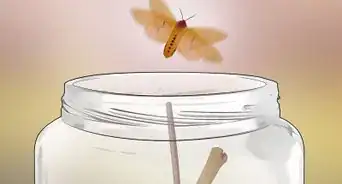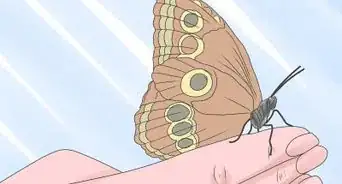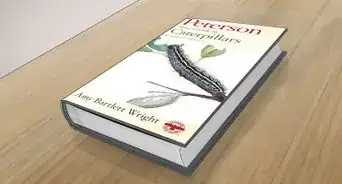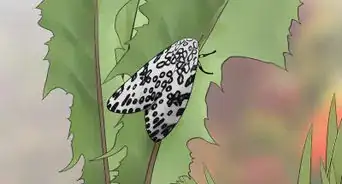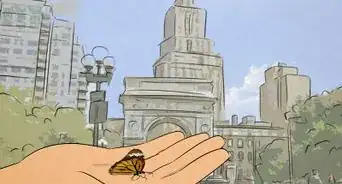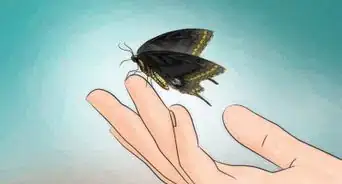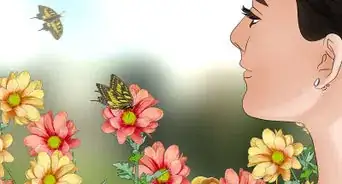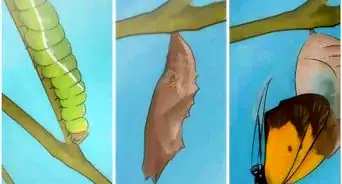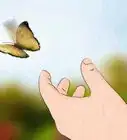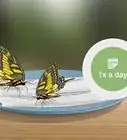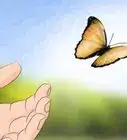This article was co-authored by Samuel Ramsey, PhD. Dr. Samuel Ramsey is an Entomologist and a researcher with the United States Department of Agriculture. Dr. Ramsey has extensive knowledge of symbiosis and specializes in insect disease spread, parasite behavior, mutualism development, biological control, invasive species ecology, pollinator health, and insect pest control. He holds a Bachelor’s degree in Entomology from Cornell University and a Ph.D. in Entomology from the University of Maryland. Dr. Ramsey’s research on bees has enabled researchers to develop targeted control techniques to restore honey bee populations worldwide. He also hosts a YouTube series called “Dr. Buggs.”
This article has been viewed 26,136 times.
Caterpillars make great pets, especially for kids. The typical caterpillar can be about 2.3 inches (6 centimeters) in length before advancing to the cocoon stage, and later becoming a butterfly. Caterpillars are typically herbivores, and eat a lot to fuel the change to a butterfly. There are several steps you can take to make sure your pet caterpillars are adequately fed in advance of the metamorphosis.
Steps
Supplying Nurishing Food
-
1Identify the plant the caterpillar was collected from. Take a photo or sample stem of the plant you collected the caterpillar(s) from. If you got the caterpillar(s) from a store, then make a note of what plants were in the original habitat. If you’re unsure, use a book on botany or ask a local garden shop or pet shop expert to help figure out what the plant was.[1] [2]
- Caterpillars have specific types of food plants related by species (there are at least 160,000 species of butterflies), and will only eat from that family of plants.[3]
-
2Clean the plants. Make sure the plants you select are thoroughly washed before you feed them to your caterpillars. Run them under water from a sink faucet, but don’t soak them so much they begin to wilt. Leave some droplets of water on the plants for the caterpillars to drink.[4] [5]Advertisement
-
3Put the plants in a glass of water. This is a good way to keep the plant supply fresh at least while the caterpillars are young.[6] Set up a glass of clean water just tall enough to fit in the caterpillar’s habitat. It can be a cup or even a small vase. Put the plants into the water, stalk first, and let the leaves rest up and over the top. Leave paper towels under the cup and plant to absorb any moisture or droppings.[7] [8]
-
4Lay the plants along the bottom of the tank. This is an alternative to the glass of water method, but plants placed in this manner can dry up and rot faster. Place the stalk and leaves bunched along the bottom of the habitat. Allow them to rest along the length of the tank without running up the sides. If length is an issue you can use a pair of scissors to cut the stalk shorter. Leave the leaves intact.[9] [10]
Replacing Old Food
-
1Replace used food. As soon as you notice the leaves in the glass or on the bottom of the tank wilting, or see them eaten up, replace them.[11] What you replace the food with depends on the species of caterpillar you have. Some allow a more varied diet within the family of plants. If this is the case you should put in one of the other types. If the caterpillar does not eat it, then put the first type back in.[12] [13]
- Remember to wash the plants each time you replace them.
-
2Change to other food plants. Only use this method if the species of caterpillar you have can eat multiple types of food plants within a plant family. Go to a local plant nursery and collect supply of the other plants in the family. Make sure you get intact leaves. Also make sure the plants are not treated with pesticides. Place only one of the varieties into the cup or tank bottom at a time. Watch if your caterpillar is eating the leaves. If not, then you should swap out to another variety.[14] [15] [16]
- An example of plants in the same family would be leaves from apple, cherry, and plum trees. All come from the family “rosaceae.”
-
3Put a variety of plants in the tank. This is a method to consider for multi-plant eating species only. You can leave a stalk of the original plant the caterpillar(s) came from in the glass or cage bottom. Add other food plants from the species-appropriate family of plants into the glass or tank bottom. Examine the leaves as you do this to make sure none are damaged or wilted before you put them in. If you notice the caterpillars ignoring one particular variety of plant, then you should remove it and not attempt to give it again.[17] [18] [19]
- An example of a multi-plant eating species is the viceroy butterfly. The caterpillar can eat leaves from the willow, poplar, aspen, apple, cherry, and plum trees.
- Wash the plants before introducing them.
Expert Q&A
-
QuestionWhy does my caterpillar refuse to eat some leaves?
 Samuel Ramsey, PhDDr. Samuel Ramsey is an Entomologist and a researcher with the United States Department of Agriculture. Dr. Ramsey has extensive knowledge of symbiosis and specializes in insect disease spread, parasite behavior, mutualism development, biological control, invasive species ecology, pollinator health, and insect pest control. He holds a Bachelor’s degree in Entomology from Cornell University and a Ph.D. in Entomology from the University of Maryland. Dr. Ramsey’s research on bees has enabled researchers to develop targeted control techniques to restore honey bee populations worldwide. He also hosts a YouTube series called “Dr. Buggs.”
Samuel Ramsey, PhDDr. Samuel Ramsey is an Entomologist and a researcher with the United States Department of Agriculture. Dr. Ramsey has extensive knowledge of symbiosis and specializes in insect disease spread, parasite behavior, mutualism development, biological control, invasive species ecology, pollinator health, and insect pest control. He holds a Bachelor’s degree in Entomology from Cornell University and a Ph.D. in Entomology from the University of Maryland. Dr. Ramsey’s research on bees has enabled researchers to develop targeted control techniques to restore honey bee populations worldwide. He also hosts a YouTube series called “Dr. Buggs.”
Entomologist Caterpillars have taste buds. Different kinds of caterpillars eat only certain types of leaves. They eat soft leaves and do not like crispy leaves. If you do not give them the leaves of their choice, they will not eat them.
Caterpillars have taste buds. Different kinds of caterpillars eat only certain types of leaves. They eat soft leaves and do not like crispy leaves. If you do not give them the leaves of their choice, they will not eat them. -
QuestionAre caterpillars gregarious by nature?
 Samuel Ramsey, PhDDr. Samuel Ramsey is an Entomologist and a researcher with the United States Department of Agriculture. Dr. Ramsey has extensive knowledge of symbiosis and specializes in insect disease spread, parasite behavior, mutualism development, biological control, invasive species ecology, pollinator health, and insect pest control. He holds a Bachelor’s degree in Entomology from Cornell University and a Ph.D. in Entomology from the University of Maryland. Dr. Ramsey’s research on bees has enabled researchers to develop targeted control techniques to restore honey bee populations worldwide. He also hosts a YouTube series called “Dr. Buggs.”
Samuel Ramsey, PhDDr. Samuel Ramsey is an Entomologist and a researcher with the United States Department of Agriculture. Dr. Ramsey has extensive knowledge of symbiosis and specializes in insect disease spread, parasite behavior, mutualism development, biological control, invasive species ecology, pollinator health, and insect pest control. He holds a Bachelor’s degree in Entomology from Cornell University and a Ph.D. in Entomology from the University of Maryland. Dr. Ramsey’s research on bees has enabled researchers to develop targeted control techniques to restore honey bee populations worldwide. He also hosts a YouTube series called “Dr. Buggs.”
Entomologist Caterpillars like to have company. So you can raise a bunch of them together. But do not keep too many of them in a single cage. See to it that each of them has enough to eat and they are not overcrowded.
Caterpillars like to have company. So you can raise a bunch of them together. But do not keep too many of them in a single cage. See to it that each of them has enough to eat and they are not overcrowded. -
QuestionWhen do woolly bear caterpillars go into their cocoons?
 Samuel Ramsey, PhDDr. Samuel Ramsey is an Entomologist and a researcher with the United States Department of Agriculture. Dr. Ramsey has extensive knowledge of symbiosis and specializes in insect disease spread, parasite behavior, mutualism development, biological control, invasive species ecology, pollinator health, and insect pest control. He holds a Bachelor’s degree in Entomology from Cornell University and a Ph.D. in Entomology from the University of Maryland. Dr. Ramsey’s research on bees has enabled researchers to develop targeted control techniques to restore honey bee populations worldwide. He also hosts a YouTube series called “Dr. Buggs.”
Samuel Ramsey, PhDDr. Samuel Ramsey is an Entomologist and a researcher with the United States Department of Agriculture. Dr. Ramsey has extensive knowledge of symbiosis and specializes in insect disease spread, parasite behavior, mutualism development, biological control, invasive species ecology, pollinator health, and insect pest control. He holds a Bachelor’s degree in Entomology from Cornell University and a Ph.D. in Entomology from the University of Maryland. Dr. Ramsey’s research on bees has enabled researchers to develop targeted control techniques to restore honey bee populations worldwide. He also hosts a YouTube series called “Dr. Buggs.”
Entomologist Woolly bear caterpillars go into a state of dormancy during the winter. They enter their cocoons at that time.
Woolly bear caterpillars go into a state of dormancy during the winter. They enter their cocoons at that time.
Warnings
- Caterpillars will turn to cannibalism if not given enough plant material to eat. Caterpillars will also kill and eat other species such as a moth, or another variety of butterfly.⧼thumbs_response⧽
References
- ↑ http://www.amentsoc.org/insects/caresheets/caterpillars.html
- ↑ http://www.keepinginsects.com/butterfly/care/
- ↑ Samuel Ramsey, PhD. Entomologist. Expert Interview. 20 January 2021.
- ↑ http://www.amentsoc.org/insects/caresheets/caterpillars.html
- ↑ http://www.keepinginsects.com/butterfly/care/
- ↑ Samuel Ramsey, PhD. Entomologist. Expert Interview. 20 January 2021.
- ↑ http://www.amentsoc.org/insects/caresheets/caterpillars.html
- ↑ http://www.keepinginsects.com/butterfly/care/
- ↑ http://www.amentsoc.org/insects/caresheets/caterpillars.html
- ↑ http://www.keepinginsects.com/butterfly/care/
- ↑ Samuel Ramsey, PhD. Entomologist. Expert Interview. 20 January 2021.
- ↑ http://www.amentsoc.org/insects/caresheets/caterpillars.html
- ↑ http://www.keepinginsects.com/butterfly/care/
- ↑ http://www.joyfulbutterfly.com/what-do-caterpillars-eat/
- ↑ http://www.amentsoc.org/insects/caresheets/caterpillars.html
- ↑ http://www.keepinginsects.com/butterfly/care/
- ↑ http://www.joyfulbutterfly.com/what-do-caterpillars-eat/
- ↑ http://www.amentsoc.org/insects/caresheets/caterpillars.html
- ↑ http://www.keepinginsects.com/butterfly/care/
About This Article
To feed caterpillars, start by identifying the plant your caterpillars were collected from, since diets vary across species. If you aren't sure, you can consult a botany book or talk to a local pet shop owner. Once you know what plants your species likes, collect or buy leaves from that kind of plant and rinse the foliage off thoroughly. Then, you can scatter the leaves on the aquarium floor or place them in a cup of water before putting them in the tank so they stay fresh for several days. Once the foliage starts to wilt, take it out and replace it with a fresh batch! For tips on experimenting with a variety of plants, read on!
